








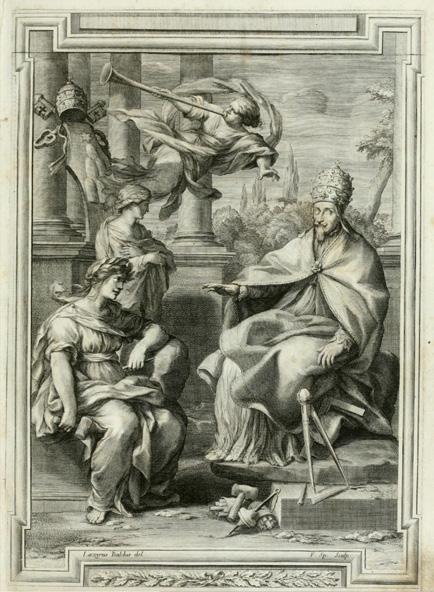
The statue of Alexander VII, refusing to be completed (see p. 199)
Imagine a population, one fourth of which consists of priests, one fourth of statues, one fourth of people who hardly do anything, and the remaining fourth who do nothing at all.
Charles de Brosses
As in Rome there is, apart from the Romans, a population of statues, so apart from this real world there is a world of illusion, almost more potent, in which most men live.
Goethe

Rome is a city of statues. Statues of saints, popes, emperors, angels, gods, and heroes. There is even, in the little Piazza della Minerva, a statue of an elephant carrying an obelisk on its back.
Rome is a place of chance and depth. Whatever your itinerary, it will be derailed by something unexpected and profound around a corner that you never even planned on turning. On my first trip to Rome in the mid-70s, I was booked into a very studenty pensione by the Pantheon, up three flights of narrow stairs. As I climbed up to the reception desk, I was pressed against a wall by two stretcher bearers bringing a stiff down the stairway: a suicide who chose a dramatic check out. I soon learned he was the previous occupant of my room. Rather than wait for the housekeeper to ‘prepare’ things, I went out for a walk aiming to go from one tourist honeypot—Piazza della Rotonda, the square of the Pantheon —to the next—Piazza Navona—by way of Ditta Gammarelli, the papal tailors who sold (and still sell) beautiful socks in the appropriate colours for bishops, cardinals and popes.
First stop, the Pantheon itself, ancient Rome’s most complete surviving building, saved for future generations thanks to the Emperor Phocas’ decision in 609 ad to give it to Pope Boniface V for conversion to a Christian church. Two nineteenthcentury kings of Italy are buried there. More interestingly, so are the artists Raphael, Annibale Carracci and Taddeo Zuccaro, whose resting places testify to the high esteem in which
Opposite: The young Taddeo Zuccaro, guided by Pallas Athene (Minerva), has his first glimpse of Rome. The Colosseum, Trajan’s Column and the Pantheon can all be seen
artists were held by Italian culture. No artist could wish for a better epitaph than (in Thomas Hardy’s translation):
Here’s one in whom Nature feared—faint at such vying— Eclipse while he lived, and decease at his dying.
The lives of all three artists also testify to the magnetic lure of Rome. Carracci came there from Bologna while Raphael and Zuccaro made the journey from Urbino. For centuries, Rome was where artists made their reputations and fortunes.
As interesting as both artists’ tombs are, the overwhelming fact of the Pantheon is its great dome—the largest concrete dome in the world until the twentieth century, made even more remarkable by its open top or oculus which let the smoke from ancient Roman sacrifices rise to the heavens. On subsequent visits I’ve been lucky enough to watch rain fall through it, and once, magically, snow. On my first visit, and indeed on almost every later one, there was a huge crowd of tourists and a scattering of guardian flunkeys trying to preserve the decorum of the place, which after all is still a working church. There was a lot of official shouting ‘silenzio’ and a battle to ensure that no wearing of tank tops and short shorts be allowed.
After enough dome, it was time to wander. And that’s when I walked through Piazza della Minerva and saw a three hundred-year-old elephant carrying a three-thousand-yearold obelisk in front of the mediæval church of Santa Maria sopra Minerva.

That was the moment—a dreamlike convergence of Egyptian, Baroque, Gothic, pagan and Christian—that Rome had me: what I later decided was my ‘Goethe moment’. In his Italian Journey, Goethe, the most penetrating and subtle of all Grand Tourists, wrote how he was bewildered and intoxicated by Rome, ‘an entity which has suffered so many drastic changes in the course of two thousand years, yet is still the same soil, the same hill, often even the same column or the same wall’. This constant rubbing up against the past makes the observer into ‘a contemporary of the great decrees of yesterday’, as Goethe put it. In Rome, history is more than a spectator sport.
Because history is part of everyday Roman life, it is, while much appreciated, not always taken so seriously. The Minerva elephant is hardly anatomically correct. Its squat body, extended trunk, high domed forehead and quizzical expression have a lot in common with Bernini’s celebrated caricatures of contemporary bigwigs. Indeed the elephant’s cartoon-like qualities apparently led Romans to give it an affectionate nickname—‘Il pulcino della Minerva’ or ‘Minerva’s chick’ although I must confess that while I have read that, I have never heard anyone refer to it as such. Some have speculated that ‘pulcino’ should really be ‘porcino’, or piglet. I don’t think it looks like either a chick or a piglet: it is freighted with far too much grand symbolism.
Over its back is a richly carved saddle blanket adorned with the coat of arms of Fabio Chigi, who reigned as Pope Alexander VII from 1655 until 1667 . The elephant stands on
an elephant in rome
a high plinth carved with arcane Latin inscriptions roughly translated as:
let any beholder of the carved images of the wisdom of egypt on the obelisk carried by the elephant, the strongest of beasts, realise that it takes a robust mind to carry solid wisdom and in the year of salvation 1667, alexander vii dedicated to divine sapience this ancient egyptian obelisk, a monument to egyptian pallas, brought from the earth and erected in what was formerly the square of minerva, now that of the virgin who gave birth to god.
The elephant turns his head sharply backwards, with eyes up to heaven and the hint of a sly smile. And he swishes his tail to the side as if about to defecate. The first time I saw it, I was impressed by the beauty and vivacity of its carving, and entertained by its humour, but also puzzled by its downright weirdness. Why the elephant? Why the obelisk? The answers took me into the heart of Baroque Rome.
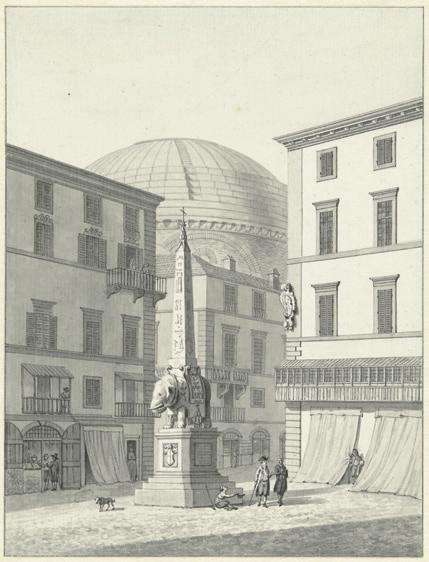
The view of the Piazza della Minerva from the Grand Hotel de la Minerve in 1790, much as Stendhal would see it twenty years later. S Maria sopra Minerva is out of the picture to the right
Piazza della Minerva is not among the grandest squares in Rome. It doesn’t attract the throngs that crowd Piazza Navona or Piazza della Rotonda, the square of the Pantheon. There are no cafés and no fountain. There is Santa Maria sopra Minerva, the only Gothic church in Rome, and a dignified hotel, the Grand Hotel de la Minerve. The latter was much favoured by nineteenth-century celebrities, not least Stendhal. The novelist was celebrated for his description of ‘hyperkulturemia’, or Stendhal’s Syndrome: a symptomatic bundle of heart palpitations, nausea, dizziness and confusion caused by too much exposure to too much great art. It’s still a not uncommon reaction of first-time visitors to Italy. Stendhal keenly recorded his impressions of the Colosseum, Saint Peter’s and a host of other Roman landmarks, but he found the view from his hotel window less arresting. In his list of eighty-six minor Roman churches he describes Santa Maria sopra Minerva as ‘having a dreadful look’ and ‘located opposite an elephant carrying an obelisk.’
It seems a rare failure of imagination. Perhaps he was already feeling the Syndrome, exposed to excessive obelisks? For while an elephant is a rare sight in the streets of Rome, obelisks are not. In fact erecting them is a Roman habit dating as far back as the time of the first emperor. After Augustus’ conquest of Cleopatra’s Egypt in 30 BCE , obelisks began arriving as potent reminders that Romans had subjugated the world’s most long-established civilisation. The very transportation and re-erection of these great stones—the obelisk in Saint Peter’s Square, for example, is twenty-five
metres high and weighs over 300 tonnes—was also a symbol of Roman willpower and technical skill. Before long, obelisks proliferated, marking the sports stadia, places of worship and imperial tombs of ancient Rome. After the empire fell, the obelisks started falling too, victims of neglect; just one remained standing. Succeeding centuries heaped up builder’s rubble and common rubbish over all the rest.
Not until the end of the sixteenth century was the custom of raising obelisks revived. Beginning in 1584, the uncouth and violent Pope Sixtus V re-erected four, using them as exclamation points in the Roman cityscape. They defined a network of roads linking the Piazza del Popolo—the traditional grand entrance to Rome—with Saint Peter’s and the great basilicas of Saint John Lateran and Santa Maria Maggiore, imposing a new order on Rome and making it easier for pilgrims and other visitors to navigate the city. These obelisks had massive propaganda value as well. Transformed into Christian monuments, they embodied the triumph of the Church over the pagan Roman Empire and, in the face of the trauma of the Reformation and the rise of Protestantism, proclaimed that Rome was still in business as the Holy City.
Today there are thirteen standing obelisks in Rome, eight dating back to the temples of ancient Egypt and five made to order in Egypt for the ancient Romans: more than any other city in the world, more even than remain in Egypt herself. But even with all this competition – not to mention that of such curious monuments as the Pyramid of Cestius or the

The obelisks of Rome in 1618
Bocca della Verità – the elephant and obelisk of the Piazza della Minerva is still among Rome’s most captivating sights.
More than that, to me it is also a key that helps unlock the complexities of papal intrigues, European power politics and the artistic and intellectual life of seventeenth-century Rome. Above all, it also helps to explain why Rome looks the way it does.
Overleaf: Rome as reorganized by Sixtus V. A star-like grid of roads connects the main churches of Rome, most clearly Santa Maria del Popolo (bottom left) to the Lateran (top right), passing Santa Maria Maggiore in the centre of the picture, all of them signposted by obelisks. The inscription reads: ‘When he opened the direct paths to the holiest churches, Sixtus himself opened the way to the stars’



Gian Lorenzo Bernini, Self-portrait painted c. 1621, the year he was knighted by Pope Gregory XV at the age of only twenty-three
an elephant in rome
The elephant of the Piazza Minerva is the creation of Gian Lorenzo Bernini ( 1598-1680), an artist who dominated Europe like no other of his time (no mean feat in the age of Rubens, Rembrandt and Velázquez). The sheer volume and variety of Bernini’s work in Rome are dizzying, ranging from monuments and statues to fountains, chapels and churches, palaces and piazzas. He is synonymous with the Rome of Baroque drama, highly emotional piety, thrilling vistas, and the feeling, though no longer the reality, that the Holy City remains caput mundi , the ‘head’ or capital of the world.
If Rome was not built in a day, neither could it be built by one man, even one as driven and talented as Bernini. Before there was a fully developed commercial market for art, great artists required great patrons, and Bernini had the greatest patrons of all: the popes. Reimagining a city is an act of political will as much as a work of art: in seventeenth-century Rome, political, economic and spiritual power collected around the person of the reigning pope, and a succession of popes made Bernini their man.* He was discovered as a
*Bernini’s long life stretched across the reigns of ten popes: their names as well as those of a few of their predecessors will feature in this story. Some of them reigned very briefly—Leo XI, for example, was Pope for just twenty-six days—and others didn’t play a very large part in Bernini’s career. Please do not be put off by the thought of having to remember so many different pontiffs: rather like the characters in a Russian novel, the important ones will become obvious. Popes will be referred to by their given names until they became Pope, and then by their regnal names. For example, the man we know as Maffeo Barberini until his election in 1623 then becomes Urban VIII; similarly, Fabio Chigi becomes Alexander VII.

The popes during Bernini’s working life. Left to right from the top: Paul V, Gregory XV, Urban VIII, Innocent X, Alexander VII, Clement IX, Clement X, Innocent XI. The last one, Alexander VIII, was a close friend, but only elected after Bernini’s death
an elephant in rome
youth by Paul V (reigned 1605-21 ), developed a close friendship with the opulent and expansive Urban VIII ( 1623-44 ) and, after an almost career-ending falling out, created sublime work for Innocent X (1644-55 ). But his most remarkable and productive relationship was with Alexander VII ( 1655-67 ).
And it was as the ailing Alexander VII neared the end of his twelve years on the throne of St Peter that the pope himself and Bernini chose to celebrate his reign and its vast achievements with this modestly-sized, charming and frankly enigmatic statue of an elephant. It turned out to be Bernini’s final tribute to his friend and collaborator. Alexander died just days before it was unveiled.
Easter Sunday, 10 April 1667, and Bernini was a worried man. A Roman proverb said that ‘the pope isn’t sick until he’s dead’, but Bernini and an increasing number of Romans knew that Pope Alexander VII was very sick indeed. Easter Sunday was, as it remains, a time for the reigning pope to address his flock. That Easter there was doubt that Alexander would be able to appear before the large crowd gathering on the piazza in front of the Quirinal Palace in Rome, many drawn by piety, others by anxiety, or curiosity, or a mixture of all three. Set on the top of Rome’s highest hill, the Quirinal Palace had originally been a papal summer residence. The relatively cool breezes and distance from the polluted Tiber provided relief from the unhealthiness of the Vatican or the inconvenience and
lack of comfort of the pope’s traditional residence, the Lateran. Alexander, a life-long invalid, had made the Quirinal his permanent home. Popes were often elderly when elected and not expected to reign for long, and this had been especially the case when Alexander was chosen in 1655 . Plagued by a variety of kidney problems from boyhood, his health had declined shockingly during his many years as a papal diplomat in Germany, where he was tormented by the cold and damp and had lost all his teeth. (Rich and articulate as he was, the toothless pope lived on a diet of baby food, and his speech was often hard to understand.) It was frankly surprising that his papacy had lasted for twelve years, but by Holy Week in 1667 it was clear his time was running out. A month earlier he had struggled to preside over a meeting of the College of Cardinals at which he promoted eight clerics to the red hat. Rome had long buzzed with gossip about the ever-ailing pope’s health, and on Easter Sunday the crowd at the Quirinal continued to grow, and with it the uncertainty that they would get to see the pope. Finally, Alexander presented himself on the balcony and, with great effort, blessed his flock. It was his last public appearance. Five weeks later he was dead.
In the weeks of the pope’s final illness, the finishing touches were being put on two monuments to his reign. The scholarly Alexander had long wanted to establish a great new library, which, in his words, would be ‘for the public benefit of lecturers, students and scholars’, at Rome’s historic university, La Sapienza. With the pope on his deathbed, a

The death of Alexander VII, as imagined by a Dutch artist in 1698
bull—an official decree or charter—was issued naming the new library the Biblioteca Alessandrina in his honour. At the same time, a team of Bernini’s craftsmen, led by his most talented collaborator, Ercole Ferrata, was hurrying to finish the elephant and obelisk in the Piazza della Minerva.
The impending death of a pope always threw Rome into barely suppressed panic. Unlike a hereditary monarchy where the formula ‘The king is dead, long live the king’ epitomises the seamless transition from one sovereign to another, the death of a pope required an election for his successor, a lengthy and uncertain process. Cardinals had to gather, factions form, deals be made, the great Catholic monarchs of France and Spain be consulted, appeased or resisted. It could take weeks or months to elect a new pope.
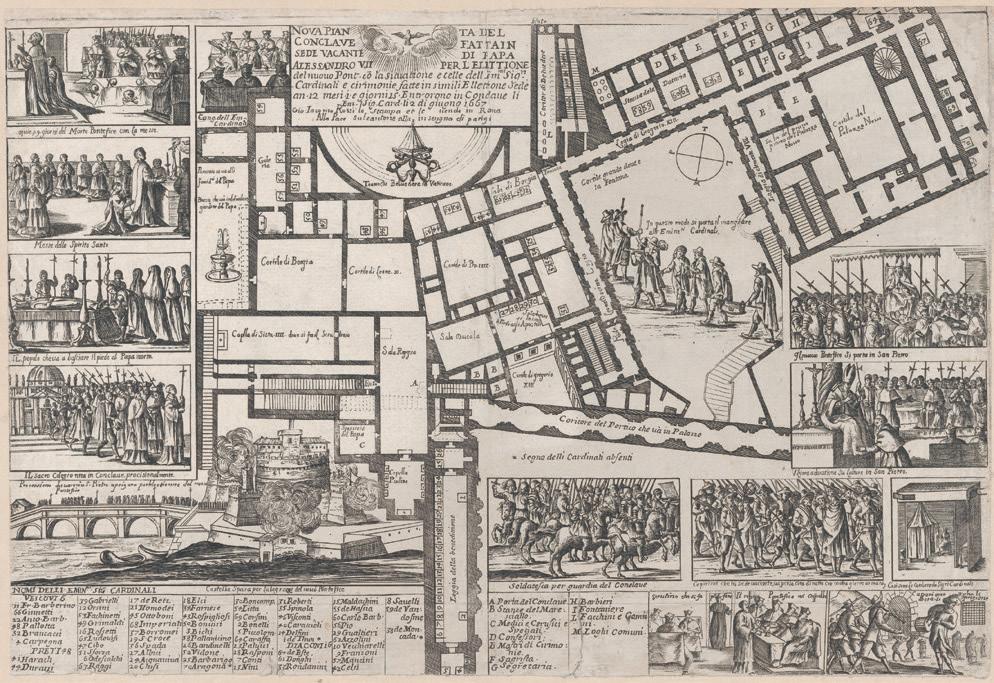
Ceremonies after the death of Alexander VII, 1667. Prayers are said, the people kiss the feet of the late pontiff, and the cardinals process from Saint Peter’s to the conclave. Salutes are fired from Castel Sant’Angelo

The cardinals are installed in little cabins within rooms at the Vatican; food is brought to them under guard. Armed militias patrol Rome. Once chosen, the new pontiff is chaired through the city
Nor was it just Rome that would be nervous. A papal election threatened the precarious stability of Europe, still recovering from the trauma of the Thirty Years’ War and slowly adjusting to the fading of Spanish military and economic strength and the increasing aggression of France under the young king, Louis XIV. Unlike any other sovereign, the pope was master of two empires, spiritual and secular. As supreme pontiff of the Catholic Church his domain spread across the world. He commanded obedience from Jesuit missionaries in China and converted tribes in South America. And even though aggressive Protestantism had been eroding papal authority in Europe for over a century, kings and merchants and craftsmen and peasants from Poland to Portugal still acknowledged the pope’s religious authority. Of equal, maybe greater, practical importance was the pope’s political power base. Seventeenth-century Italy was, as Metternich cynically described it in 1814 , ‘merely a geographical expression.’ The peninsula was divided amongst dozens of city states, principalities and duchies, most with their own customs, dialects and favourite foods. It was a crazy patchwork of conflicting sovereignties, shifting alliances and failed ambitions. The Kingdom of Spain remained the greatest power in the land, controlling the whole south of the mainland, along with Sicily and Sardinia. Spain’s royal cousins, the Austrian Habsburgs, coveting a window onto the Mediterranean, put constant pressure on the slowly declining Republic of Venice. To the northwest, France loomed over Lombardy and the Duchy of Savoy. Tuscany was in play. The

Map of Italy: the Papal States are in green, stretching across the middle of the peninsula. Rome is close to the southernmost tip of the States
pope’s secular domains, the Papal States, were central to the geography and politics of Italy, stretching diagonally across the peninsula from the sunny Sabine Hills south of Rome to the fogs of the Po Valley bordering Venetian territory. Perugia, Bologna, Ferrara, Rimini, Spoleto, Ravenna and Ancona were all papal cities, but the cornerstone of the Papal States was the status and security of Rome, caput mundi , an epithet that had less to do with Rome’s size or wealth or political significance, than with its absolute and unquestioned centrality to European civilisation. The fate of all this was in the balance with every change of papal ruler.
In Rome itself, during the anxious weeks of Alexander’s last illness, his relatives, colleagues and retainers tensely awaited the sound of the ‘Patara’, the great bell of the Capitol whose tolling would signal the pope’s death. Their incomes and privileges and status would die with the pope. A new pope would bring with him a new family that had to be enriched with benefices and sinecures and who needed to aggrandize old palaces or buy or build new ones. And there would be new favourites to fill the papal court: musicians and poets and scholars and painters and sculptors and architects. Not just patronage, but papal authority died with the pope too: the normal workings of justice were suspended, prison gates were opened and old scores were settled as vengeance was sought for resentments that had simmered for years. The civic government of Rome, the Popolo Romano, which had little authority and little to do while the pope lived, vainly attempted to impose some order on the city after the pope’s death. This period known as the sede vacante, or vacant see, was a time for lawlessness and anarchy. It was a time too for the populace to express, often violently, their grievances against the papal régime that had just ended. Bernini, the papal favourite, had much to fear for the safety of himself and his family, for his business, his honour and his reputation.
Bernini had grown up amidst the marble dust and chisels of the sculptor’s workplace. His father, Pietro, was a successful sculptor, even a modestly well-known one,
an elephant in rome celebrated for his extreme technical skill in stone carving. But Pietro’s technique far outran his compositional and æsthetic abilities, and he never quite got to the first rank of practitioners. Born in 1562 in Sesto Fiorentino, on the outskirts of Florence, the son of a cobbler, his natural talents took him far from his origins in the Tuscan peasantry, gaining him an apprenticeship in Florence, from which he moved to Rome for four years and then further to Naples, where he settled for twenty years. At the end of the sixteenth century, Naples was, after Paris, the biggest city in Europe, and the seat of a powerful and rich viceregal court that ruled all of Southern Italy and Sicily on behalf of the Spanish Habsburg monarchy. The embellishment of Neapolitan churches, palaces and monasteries provided ample and well-paid work for Pietro, who married a local girl and fathered thirteen children. Gian Lorenzo, his first son, arrived on 7 December 1598 .
Pietro’s work in Naples brought him to the attention of the papacy, always on the lookout for artists and craftsmen. In 1605 he was summoned to Rome to work on the decoration of Santa Maria Maggiore, one of the four major papal basilicas as well as one of the city’s seven pilgrimage churches. This was a typical career path for artists on the way up in the sixteenth and seventeenth centuries. Make a mark in one of Italy’s many regional court cities and then wait for the call to Rome, where the papacy had the grandest commissions and the greatest budgets on offer. In Rome, Pietro was paid well enough to build a substantial house
secretary of state were the pope’s two closest confidantes. While the cardinal-nephew was much more richly remunerated—after all he was a member of the papal family—the secretary of state was increasingly more powerful thanks to his greater control of correspondence, diplomacy and administration. And Chigi was more powerful than most secretaries of state had been because Innocent’s cardinal-nephew was neither strong nor clever (and was eventually expelled from Rome in disgrace). So Chigi was back in Rome as Pope Innocent was entering his late seventies. There would be a papal election before too long and the new secretary of state was inevitably being talked up as a possible successor. From Bernini’s point of view these developments were entirely positive. Innocent had supported him, but reluctantly; there was no warmth between them. On the other hand, Bernini and Chigi were on the closest terms.
They may well have met earlier in their careers, but real friendship blossomed shortly after Chigi’s return to Rome, when the two men met in a cardinal’s antechamber in the Vatican Palace. As Bernini’s son described the encounter, it was love at first—or perhaps second—sight: ‘Such were the greetings and displays of esteem exchanged between the two men that one could well comprehend, from that moment on, the depth of the hitherto hidden mutual attraction with which talent binds the spirit of her disciples. From this reciprocal esteem there was readily born between the two men a most tenacious reciprocal bond of friendship and
affection, which was then to grow, ever advantageously, with the passing of the years.’ Thus began a sixteen-year partnership between the future pope who had the soul of an artist and the artist who had the soul of an imperious pope.
Their first joint project was the restoration and improvement of the Chigi family chapel in the church of Santa Maria del Popolo. Nearly 150 years after its design by Raphael the chapel was unfinished and neglected—an embarrassment to the future Pope. The church is prominently sited, right next to the most important gateway through which foreign visitors entered Rome. Chigi who had recently been appointed Cardinal priest naturally wanted the chapel to exalt his family and also perhaps to signal his future ambitions. The job suited Bernini too. He had already challenged Michelangelo with his own David , now by finishing Raphael’s work, he was clearly establishing himself as the equal of the other great Renaissance master too. Bernini created portrait medallions of the Chigi ancestors for two pyramidal shaped tombs—another example of Egypt in Rome—and carved two great statues, Daniel and Habakkuk, to create a chapel newly fit for a would-be Pope.
Work was still continuing on this commission when Innocent died in January 1655. Once again, the papal election was lengthy and highly political; and once again it pitted French interests against Spanish. Cardinal Giulio Sacchetti was again the leading contender, enthusiastically backed by Cardinal Mazarin and the French. Consequently the cardinals were told that the King of Spain was effectively
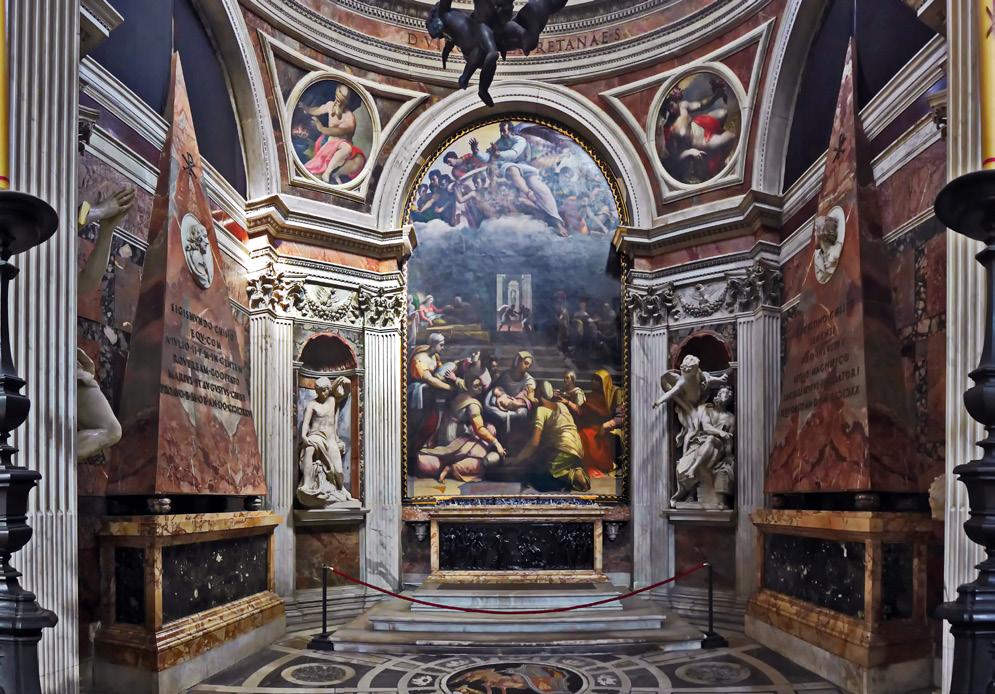

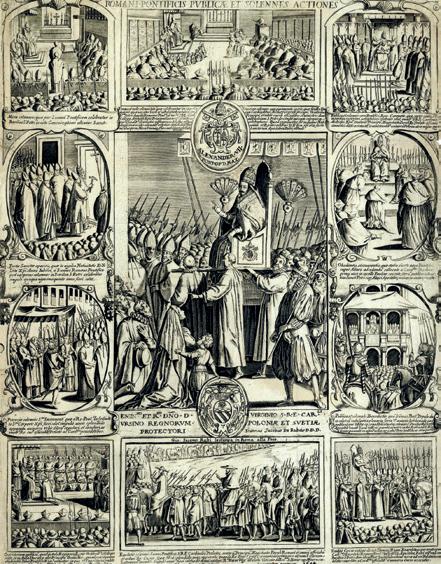
The public and solemn deeds of the Roman Pontiff 1655. Following the example of Sixtus V, Alexander VII declared a Jubilee for his accession, and this print shows the various ceremonies involved
vetoing Sacchetti’s candidacy. The French then announced that they would veto Chigi. After eighty days of wrangling and a last-minute plea by the also-ran Sacchetti that France should drop its opposition, Chigi was elected with the backing of an energetic group of independent cardinals known as the squadrone volante or flying squad, and took Alexander as his regnal name.
Alexander’s papacy got off to a promising start, by apparently providing a contrast with the corruption of his Barberini and Pamphili predecessors. He repudiated nepotism and refused to hand out well-paid jobs to his family, remarking that as Fabio Chigi he had brothers and nephews, but as pope he had no relatives. Unfortunately his resolution turned out to be neither practical nor long-lasting. Just over a year after his election he summoned his family from Siena and began the inevitable doling out of sinecures, estates and titles.
Meanwhile, however, the new pope had scored a notable triumph in his election year with the arrival in Rome of the newly converted Queen Christina of Sweden. Christina’s father, Gustavus Adolphus, the Lion of the North, had been the outstanding Protestant hero of the war. Now his daughter had abdicated her throne and was coming to Rome as the pope’s vassal. Her turning to the Church of Rome seemed to rebuke the Reformation and partially redeemed the disappointing—for the Catholics that is—outcome of the Thirty Years’ War. This diplomatic coup was to be marked by elaborate processions and ceremonies to welcome the former queen.
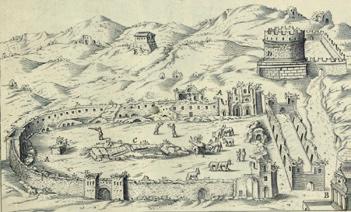
the late 16th century.
payment for the obelisk, but was unable to figure out how to get it back to his estate in England.
Popes were usually keen to secure power bases in Rome in order to establish new family dynasties or enhance the credibility of old ones. Innocent was no exception to this rule. He built a grand church and palace on the Piazza Navona, where his family had been living since the late fifteenth century and, as we have seen, after some intrigue, commissioned Bernini to design a fountain as the square’s new centrepiece and as a further Roman attraction for the Holy Year of 1650 . The incorporation of an obelisk into the fountain was fitting. Piazza Navona had been the site of chariot races and would have been embellished with obelisks. More significantly, Innocent required a major piece of statement architecture, not just about the magnificence of his family and his papacy, but also about the Church
an elephant in rome
triumphant, at a time of some despair over the unsuccessful conclusion of the Thirty Years’ War. Bernini’s design was a masterpiece of beauty, engineering and symbolism. The ninety ton obelisk is spectacularly set on a base depicting the major rivers of the world—the Danube, the River Plate, the Nile and the Ganges, representing Europe, America, Africa and Asia—clustered around a cave-like void and topped not with a cross, like Sixtus’s christianised obelisks, but with a dove, conveniently not only the image of the Holy Spirit but also the heraldic symbol of Innocent’s family, the Pamphili. The structure of the base reflects Kircher’s theory in which rivers were fed from vast subterranean reservoirs
Kircher’s theory of the origin of rivers in his Mundus Subterraneus, 1665, one of the first books on physical geography
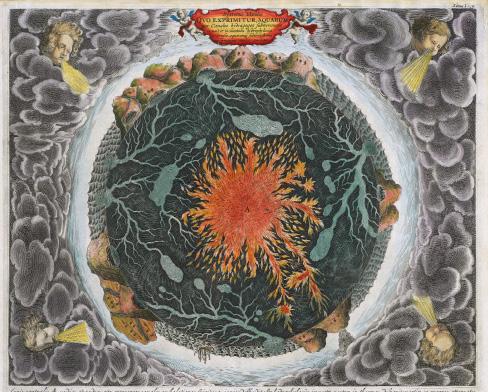

Following Rome’s example, obelisks became urban status symbols. When New York was about to acquire its own obelisk for Central Park in the late nineteenth century, the New York Herald declared that ‘it would be absurd for the people of any great city to hope to be happy without an Egyptian Obelisk. Rome has had them this great while and so has Constantinople. Paris has one. London has one. If New York was without one, all those great sites might point the finger of scorn at us and intimate that we could never rise to any real moral grandeur until we had our obelisk.’
There are thirteen standing obelisks in Rome: more than any other city in the world, more than in Egypt itself. All thirteen can be visited in a day’s walking tour. But as this itinerary will take you through some of the most interesting neighbourhoods of Rome, it is perhaps better to break it up into a few parts and take it at a more leisurely pace with plenty of time for cups of coffee, aperitifs, lunch and of course the sort of discursive sightseeing which makes Rome so rewarding. You will do a great deal of walking—the whole route is around 15 kilometres—and develop an increased appreciation of Rome’s hilly topography: the legendary ‘City of Seven Hills’ nickname is a geographical understatement. The speed at which you travel from obelisk to obelisk is going to be very much affected by Rome’s often challenging weather, especially in the furnace-like conditions of peak summer days and the occasional monsoon-heavy rains. The city’s good but limited underground system won’t be much help, and I’m afraid that travelling by car is both
an elephant in rome infuriating and also rather misses the point. Rome is alas not a good city for those with limited mobility: all those hills and the beautiful but treacherous cobblestone paving present major challenges. You can follow your route on Falda’s map of 1676 , reproduced on pp. 272-283.
1.
Piazza del Popolo is a good place to start. The square’s current layout was fixed in the nineteenth century, but for centuries before it has been the gateway to Rome for visitors from the north of Italy and beyond the Alps. Amongst the most notable of these was Queen Christina of Sweden, whose conversion to Catholicism was a trophy for the Church of Rome and Pope Alexander VII in particular. In order to welcome her Alexander commissioned Bernini to redesign the square’s entrance, the Porta del Popolo, and adorn it with a Latin inscription which declares ‘May your entrance be a prosperous and happy one.’
Santa Maria del Popolo itself has, even by the high standards of Rome, outstanding treasures for such a small church. Visitors mesmerised by the Caravaggios in the Cerisi chapel may be in danger of overlooking Pinturicchio’s murals in the Della Rovere Chapel. Before he became pope, Alexander VII commissioned Bernini to finish work on his family chapel, which had been begun to designs by Raphael. The chapel features two pyramidal tombs to Alexander’s Chigi forebears, one of them to the extremely rich papal banker Agostino Chigi, as well as two outstanding Biblical sculptures by Bernini— Habbakuk and Daniel in the Lion’s Den.
As a key entry point to Rome, Piazza del Popolo was an obvious place for Sixtus V to site one of his obelisks as a signpost for visiting pilgrims. This one, sometimes called the Flaminian, was carved in Egypt around 1 , 300 BCE and brought to Rome by Augustus, who used it to decorate the central reservation of the Circus Maximus racetrack. The usual story of collapse, loss and rediscovery culminated in re-erection in 1589 with a laudatory inscription proclaiming that ‘Sixtus V ordered this miserably broken and overturned obelisk to be excavated, transferred and restored and dedicated to the invincible cross.’ Piazza del Popolo is home to two cafes with fine terraces: Rosati, the slightly smarter of the two, and Canova, which attracted celebrities and papparazzi in the Dolce Vita era. The famous trident of three streets, Corso, Babuino and Ripetta, fans out from the piazza, but we will turn our back on those to walk up Via Gabriele D’Annunzio to the edge of the Borghese gardens. Ten minutes later you will get to the top of the Salita del Pincio staircase where there is an excellent view across Rome to Saint Peter’s. 2 .
Another few minutes’ walk brings you to the small—a little over nine metres tall—obelisk of Monte Pincio, commissioned in the second century CE by the Emperor Hadrian as a monument to his recently deceased lover, the teenage Greek Antinous, whom Hadrian had deified. When Giuseppe Valadier, the architect responsible for the final design of the Piazza del Popolo, took charge of the
an elephant in rome
layout of the Borghese Gardens, modern Rome’s first public park, the obelisk was re-erected not, as the obelisk historian Erik Iversen observed, to mark a significant urban space, but as a mere garden ornament. That was in 1822, during the reign of Pius VI. Today the obelisk stands as the centrepiece of a pantheon of somewhat decrepit statues commemorating largely obscure Italian worthies including a headless Carlo Botta, author of early nineteenth-century histories of Italy and the American Revolution, and a noseless G. B. Niccolini, poet, playwright and patriot. Nearby is the Casina dell’ Orologio, a painted wooden chalet dating from the 1920 s serving excellent coffee and those dubious-looking but delicious tramezzini , little triangular white bread sandwiches. A leisurely ten minute walk passes the Casino Valadier, a restaurant and event space, and the late sixteenth-century Villa Medici, home to the French Academy since 1803 . The villa and its gardens, with guided tours in various languages, are well worth visiting.
3.
Just after the Villa Medici we reach the top of the Spanish Steps and the small piazza in front of the not overly interesting French church of Santa Trinità dei Monti, the site of a medium sized 14 meter high obelisk. It is not known when or by whom the Santa Trinità obelisk was brought to Rome, but it once formed part of the decorative scheme of the celebrated gardens of the Roman historian Sallust. The obelisk was installed here on the orders of Pius VI in 1788 - 89 . In spite of its spectacular location it is not an
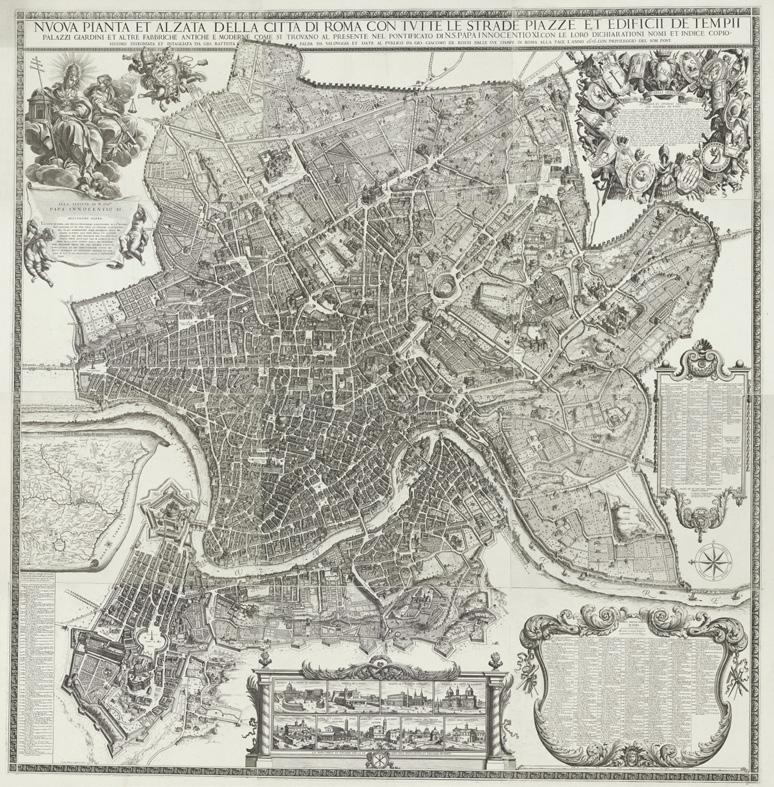

map of rome, 1676
nuova piante et alzata della città di roma con tutte le strade piazze et edifici
Drawn and etched by Giovanni Battista Falda
Published by Giovanni Giacomo de Rossi
154 x 153 cm
the obelisks of rome
1. Piazza del Popolo
2. Monte Pincio
3. Santa Trinità
4. Piazza del Quirinale
5. Vialle delle Terme
6. Santa Maria Maggiore
7. Saint John Lateran
8. Villa Celimontana
9. Palazzo Montecitorio
10. Piazza della Rotonda
11. Piazza della Minerva
12. Piazza Navona
13. Saint Peter’s Square

